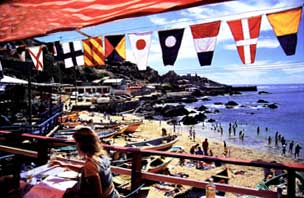| Artwork | Index | Editorial Writing | |
| Books | About | Links |
| Mary Heebner |
|
Aqua |
|
 |
|
CAST OF CHARACTERS: Madame Zunilda Tronché has presided over this small haven cantilevered above the sea at Caleta Quintay for 26 years. Caletas refer not only to the coves where boats are beached and catches sold – it is a brotherhood of fishermen who entrust their lives to the black Pacific from sundown into the early morning hours. This is Steinbeck territory. " I was born to be a commerciante", Zuni affirms, "My father, born in the village of Tronché in Southern France, and my mother began Restaurante El Rey del Congrio, just up the hill. Mama is now 84 and still works there!" Zuni's son, Alex, is the chef at her restaurant. TYPICAL CLIENTELE: On the strand of sand below the Miramar, sunbathing is an afterthought, with people flopped down among the wooden boats that are painted in bold primary colors with names like Calipso, Matador and Rambo. Besides these locals, are divers, vacationers from Santiago and Buenos Aires, week-enders from the Santa Augusta condo and golf club. GRUB AND GROG: Chile's Litoral (central coast) is a mirror image of California's Mediterranean central coast from Santa Barbara to Carmel. However, Chile offers unique riches: the golden congrio eel with delectable white meat, the pico roco, a barnacle like an impenetrable tower that yields a succulent crab-like flaky meat, the abalone – like loco, and erizos, marigold-colored sea urchin that tastes like sea foam ought to. Also on the menu; corvina, crab, oysters, and ceviche, and a refreshing Chilean salad ( tomatoes and sweet onion). Average $6 - 10 an entree. The entire back wall of Miramar is a cava of splendid Chilean wines. LOCAL KNOWLEDGE: Quintay cove is an easy 90 minute trip from Santiago. A sign about 7 miles north of Valparaiso, indicates a 26km road – paved 2/3 of the way – which roller-coasters down to the water. The nave of the old whalery frames the sea like the gutted out ribs of a leviathan. HISTORIC HIGHLIGHT: The tiny schoolhouse museum at the entrance to the town of Quintay displays a potpourri of pottery shards, worked bone tools and cranial fragments – a modest testimony to the indigenous culture who lived here up until around 1400 AD. From 1940-1967 few came to Quintay, because of the stench. Fins, Blues, Grays, Sperm, so many whales hunted, butchered, boiled, processed, then sent out to sea as fuel oil and pet food. The whalery is now used as the Acuicultura Lab and Experimental sea nursery of the University Andrés Bello in Santiago, which is raising sea urchin, lenguados and lapas to help reseed the depleated seabed. CLOSE ENCOUNTERS OF THE WET KIND: There are 3 scuba PADI certified diving schools in Santiago that regularly go to Quintay. No equipment available on site, bring your gear. Pablo Canobra (canobra@iname.com Tel.562- 321 6125), Poseidon (Tel. 562-344784) and Azul (Tel. 562 3356023). 40 meters from the dock is a sunken whaling ship about 20 meters deep. Fish are for looking only in this designated Marine Preserve Area. There is also a small cove of Quintay and adjacent to this is Playa Grande, with a long stretch of sandy beach, which is good for snorkeling on calm days.
Copyright © Mary Heebner 2000
|
|
|
|